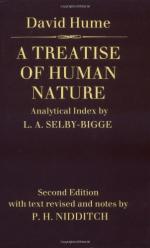
|
| Name: _________________________ | Period: ___________________ |
This test consists of 15 multiple choice questions and 5 short answer questions.
Multiple Choice Questions
1. Why does Hume say that neither ideas nor impressions are infinitely divisible?
(a) We would eventually arrive at a number too difficult to perceive.
(b) It takes away from the fact that they are complex.
(c) They are a solid fact.
(d) They can only be divided into four.
2. What does Hume believe humans generate instead of observing causes?
(a) Beliefs about causes.
(b) Judgements about causes.
(c) Morals about causes.
(d) Sympathy about causes.
3. Which of the following can cause either pride or humility?
(a) Wealth.
(b) Sympathy.
(c) Power.
(d) Death.
4. What does Hume say impressions can't tell us?
(a) That there is an external world.
(b) That there is life beyond death.
(c) That there is an internal world.
(d) That there is a God.
5. What does Hume claim should not be arrived at instinctively?
(a) Matters of love.
(b) Matters of fact.
(c) Matters of religion.
(d) Matters of science.
6. Which French philosopher does Hume reference in this section?
(a) Sartre.
(b) Malezieu.
(c) Rimbaud.
(d) Camus.
7. Which is the following is the best definition of the razor principle?
(a) If no term can be proven to come from another idea, it has no meaning.
(b) If no term can be imagined by the mind, it can never be fact.
(c) If no term can be sliced into many parts, it can't be understood by a human mind.
(d) If no term can be balanced into equal parts, it's worthless.
8. Hume tells the reader to fix his eye on what kind of spot?
(a) A dirt spot.
(b) An ink spot.
(c) A lead spot.
(d) A black spot.
9. Under what two general classes do relations come?
(a) Razor and fork.
(b) Mental and imagination.
(c) Mirror and microscope.
(d) Resemblance and contrariety.
10. Which of the following is the best description of the microscope inquiry?
(a) To understand something we must get to its core.
(b) To understand something we must take a step back and look at it.
(c) To understand something we must make it bigger.
(d) To understand something we must break it down into smaller parts.
11. For what does Hume think people mistake their perceptions?
(a) Feeliing.
(b) Friendship.
(c) Reality.
(d) Love.
12. What does Hume identify as the second philosophical relation?
(a) Quality.
(b) Resemblance.
(c) Space and time.
(d) Identity.
13. Hume says impressions are divided into what?
(a) Ideas and words.
(b) Sensation and reflexion.
(c) Love and hate.
(d) Pride and passions.
14. What is Hume's third tool of philosophical inquiry?
(a) The map.
(b) The spoon.
(c) The fork.
(d) The knife.
15. What kind of image does Hume say will be presented if one wheels around a burning coal with rapidity?
(a) A reddish orange blur.
(b) Whatever your imagination allows.
(c) A burning pole.
(d) A circle of fire.
Short Answer Questions
1. From where does Hume say sensation arises?
2. What is the title of Book one, Part Three?
3. In what does Hume say he finds it difficult to put faith?
4. What does Hume say is the chief exercise of the memory?
5. Hume says every simple impression is attended with what?
|
This section contains 522 words (approx. 2 pages at 300 words per page) |

|




